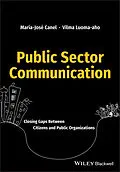A comprehensive guide to future-proofing public sector communication and increasing citizen satisfaction
How to communicate with the citizens of the future? Why does public sector communication often fail? Public Sector Communication combines practical examples from around the world with the latest theoretical insights to show how communication can help bridge gaps that exist between public sector organizations and the individual citizens they serve. The authors-two experts in the field with experience from the public sector-explain how public entities, be they cities, governments, foundations, agencies, authorities, municipalities, regulators, military, or government monopolies and state owned businesses can build their intangible assets to future-proof themselves in a volatile environment.
The book examines how the recent digitalization has increased citizen expectations and why one-way communication leaves public sector organizations fragile. To explain how to make public sector communication antifragile, the authors map contributions from a wide variety of fields combined with illustrative examples from around the world. The authors propose a research-based framework of different intangible assets that can directly improve communication in the public sector.
This important resource:
- Helps explain the sector-specific conditions and why communication is often challenging in the public sector
- Summarizes all relevant literature on the topic across disciplines and includes the most popular management ideals of the recent decades
- Explores how public sector organizations can increase citizen satisfaction with effective communication
- Presents new approaches to both the study and practice of communication in the public sector
- Provides international examples of successful public sector communication
- Offers realistic guides to building intangible assets in practice
Written for advanced undergraduate and graduate students, as well as public managers and leaders, Public Sector Communication offers an illustrative, research-based guide to improving communication and engaging citizens of today and the future.
Klappentext
Did You Know?
This book is available as a Wiley E-Text.
The Wiley E-Text is a complete digital version of the text that makes time spent studying more efficient.
Course materials can be accessed on a desktop, laptop, or mobile deviceso that learning can take place anytime, anywhere.
A more affordable alternative to traditional print,
the Wiley E-Text creates a flexible user experience:
Access on-the-go
Highlight and take notes
Search across content
Save money!
The Wiley E-Text can be purchased in the following ways:
Check with your bookstore for available e-textbook options
Wiley E-text: Powered by VitalSource®
ISBN: 978-1-119-13562-3
Directly from: www.wiley.com
Inhalt
Part I 1
1 What Is Changing in Public Sector Communication? 3
1.1 The Change: Identifying the Gaps with Citizens 3
1.1.1 What Is Changing? 3
1.1.1.1 Change in Everyday Practice 3
1.1.1.2 Answering the Most Important Question 4
1.1.1.3 Changing Values? 5
1.1.2 Changes in Individuals: Citizens, Stakeholders, Customers, and Partners 5
1.1.2.1 Changes in Citizens' Demands and Expectations 6
1.1.2.2 Citizen Communication Practices 6
1.1.2.3 Citizen Diversity 6
1.1.2.4 Changing Citizen Roles 7
1.1.3 The Traditional Gaps that Citizens Perceive When Assessing the Public Sector 7
1.1.3.1 Citizens Are from Venus, Public Authorities Are from Mars? 7
1.1.3.2 Gap 1: Speed: Bureaucracy versus Postbureaucracy 8
1.1.3.3 Gap 2: Privacy: Public versus Private Communication 8
1.1.3.4 Gap 3: Viewpoints: Process versus Answers 8
1.1.3.5 Gap 4: Context: Single Events versus General Attitude 9
1.1.3.6 Gap 5: Perceptions: Perception versus Performance 9
1.1.3.7 Gap 6: Roles: Obligations versus Rights 10
1.1.3.8 Gap 7: Media Use: Controlled versus Real Time 10
1.2 Framework for the Book 11
1.2.1 What Has Been Done on Public Sector Communication? 11
1.2.1.1 Earliest Works 11
1.2.1.2 Little Development despite the Relevance of the Topic 11
1.2.1.3 Nomenclature 12
1.2.1.4 Mapping Contributions from Different Fields to the Study of Public Sector Communication 12
1.2.2 The Three Pillars of this Book 16
1.2.2.1 The Intangible Nature of Public Sector Management 16
1.2.2.2 Knowledge for Practice, Practice for Knowledge 17
1.2.2.3 Considering Public Sector Communication from an International Perspective 17
1.2.3 Plan of the Book 17
References 18
2 What Is So Special about Public Sector Communication? 25
2.1 What Is the Public Sector? 25
2.1.1 Initial Basic Denitions 25
2.1.2 Is This Public or Private? 26
2.1.3 Scholarly Approaches to Establishing Criteria of Publicness 27
2.1.4 The Rings of Publicness 28
2.1.5 The Publicness Fan 28
2.2 Dening Public Sector Communication 30
2.2.1 Mapping Scholarly Denitions 30
2.2.2 Some Insights from Practice 32
2.2.3 Our Denition of Public Sector Communication 33
2.3 Looking at Public Sector Communication from the Publicness Fan 33
2.3.1 Different Communication? 33
2.3.2 How Public Is This and Hence How Should Intangibles and Communication be Managed? 35
2.3.2.1 Funding and Prot 36
2.3.2.2 Ownership and Employees 37
2.3.2.3 Control and Accountability 38
2.3.2.4 Purpose and Values 39
References 40
3 Fragile Public Sector Organizations 45
3.1 A Brief History of Public Sector Organizations' Development 45
3.2 Global Trends in Public Sector Management: An Overview 46
3.3 Is There a Need for Intangible Assets? 47
3.3.1 From New Public Management to New Public Service 47
3.3.2 From Management to Public Value 48
3.4 The Fragility of Public Sector Organizations 50
3.4.1 Distrust 50
3.4.2 Services and Experiences 51
3.4.3 Bureaucracy 52
3.4.4 The Political Dimension 52
3.4.5 A Tactical Approach 53
3.5 Expectations as a Cause for Public Sector Fragility 54
3.5.1 How Citizen Expectations Are Changing 54
3.5.2 Expectations through Experiences 56
3.5.3 Unmet Expectations 56
References 57
4 Antifragile Communication: Closing the Gap through Intangible Assets 65
4.1 Dening Intangible Asset 65
4.1.1 What Is an Intangible Asset About? 65
4.1.2 Pinning Down Intangibility 66
4.1.3 The Features of an Intangible Asset 67
4.2 Types of Intangibles 67
4.2.1 Accounting Categorizations 67
&...